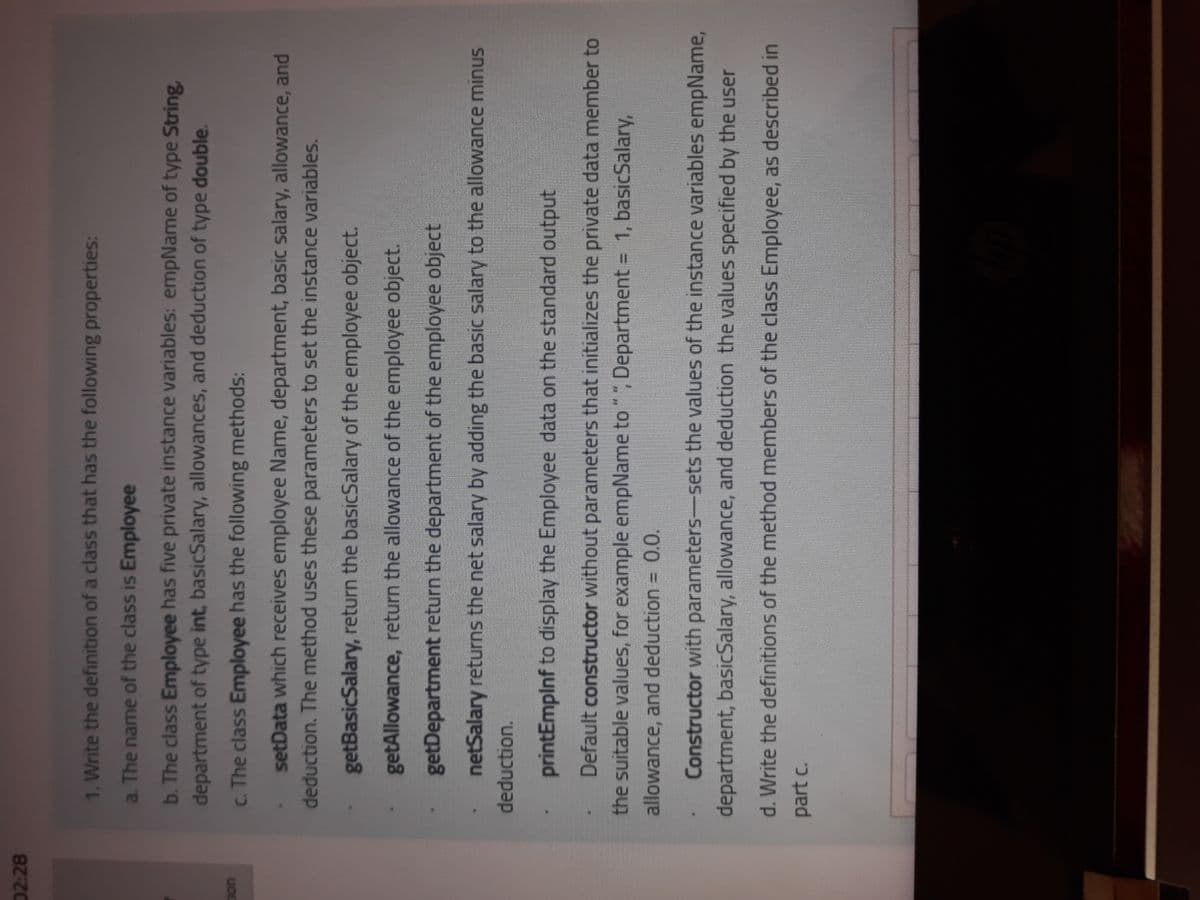1. Write the definition of a class that has the following properties: a. The name of the class is Employee b. The class Employee has five private instance variables: empName of type String, department of type int, basicSalary, allowances, and deduction of type double. c. The class Employee has the following methods: setData which receives employee Name, department, basic salary, allowance, and deduction. The method uses these parameters to set the instance variables. getBasicSalary, return the basicSalary of the employee object. getAllowance, return the allowance of the employee object. getDepartment return the department of the employee object netSalary returns the net salary by adding the basic salary to the allowance minus deduction. printEmplnf to display the Employee data on the standard output Default constructor without parameters that initializes the private data member to the suitable values, for example empName to "", Department = 1, basicSalary, %3D allowance, and deduction = 0.0. %3D Constructor with parameters-sets the values of the instance variables empName, department, basicSalary, allowance, and deduction the values specified by the user d. Write the definitions of the method members of the class Employee, as described in part c.
1. Write the definition of a class that has the following properties: a. The name of the class is Employee b. The class Employee has five private instance variables: empName of type String, department of type int, basicSalary, allowances, and deduction of type double. c. The class Employee has the following methods: setData which receives employee Name, department, basic salary, allowance, and deduction. The method uses these parameters to set the instance variables. getBasicSalary, return the basicSalary of the employee object. getAllowance, return the allowance of the employee object. getDepartment return the department of the employee object netSalary returns the net salary by adding the basic salary to the allowance minus deduction. printEmplnf to display the Employee data on the standard output Default constructor without parameters that initializes the private data member to the suitable values, for example empName to "", Department = 1, basicSalary, %3D allowance, and deduction = 0.0. %3D Constructor with parameters-sets the values of the instance variables empName, department, basicSalary, allowance, and deduction the values specified by the user d. Write the definitions of the method members of the class Employee, as described in part c.
Database System Concepts
7th Edition
ISBN:9780078022159
Author:Abraham Silberschatz Professor, Henry F. Korth, S. Sudarshan
Publisher:Abraham Silberschatz Professor, Henry F. Korth, S. Sudarshan
Chapter1: Introduction
Section: Chapter Questions
Problem 1PE
Related questions
Concept explainers
OOPs
In today's technology-driven world, computer programming skills are in high demand. The object-oriented programming (OOP) approach is very much useful while designing and maintaining software programs. Object-oriented programming (OOP) is a basic programming paradigm that almost every developer has used at some stage in their career.
Constructor
The easiest way to think of a constructor in object-oriented programming (OOP) languages is:
Question

Transcribed Image Text:02:28
1. Write the definition of a class that has the following properties:
a. The name of the class is Employee
b. The class Employee has five private instance variables: empName of type String,
department of type int, basicSalary, allowances, and deduction of type double.
c. The class Employee has the following methods:
setData which receives employee Name, department, basic salary, allowance, and
deduction. The method uses these parameters to set the instance variables.
getBasicSalary, return the basicSalary of the employee object.
getAllowance, return the allowance of the employee object.
getDepartment return the department of the employee object
netSalary returns the net salary by adding the basic salary to the allowance minus
deduction.
printEmplnf to display the Employee data on the standard output
Default constructor without parameters that initializes the private data member to
the suitable values, for example empName to"", Department = 1, basicSalary,
0.,
allowance, and deduction = 0.0.
Constructor with parameters-sets the values of the instance variables empName,
department, basicSalary, allowance, and deduction the values specified by the user
d. Write the definitions of the method members of the class Employee, as described in
part c.
Expert Solution
This question has been solved!
Explore an expertly crafted, step-by-step solution for a thorough understanding of key concepts.
This is a popular solution!
Trending now
This is a popular solution!
Step by step
Solved in 3 steps with 3 images

Knowledge Booster
Learn more about
Need a deep-dive on the concept behind this application? Look no further. Learn more about this topic, computer-science and related others by exploring similar questions and additional content below.Recommended textbooks for you

Database System Concepts
Computer Science
ISBN:
9780078022159
Author:
Abraham Silberschatz Professor, Henry F. Korth, S. Sudarshan
Publisher:
McGraw-Hill Education

Starting Out with Python (4th Edition)
Computer Science
ISBN:
9780134444321
Author:
Tony Gaddis
Publisher:
PEARSON

Digital Fundamentals (11th Edition)
Computer Science
ISBN:
9780132737968
Author:
Thomas L. Floyd
Publisher:
PEARSON

Database System Concepts
Computer Science
ISBN:
9780078022159
Author:
Abraham Silberschatz Professor, Henry F. Korth, S. Sudarshan
Publisher:
McGraw-Hill Education

Starting Out with Python (4th Edition)
Computer Science
ISBN:
9780134444321
Author:
Tony Gaddis
Publisher:
PEARSON

Digital Fundamentals (11th Edition)
Computer Science
ISBN:
9780132737968
Author:
Thomas L. Floyd
Publisher:
PEARSON

C How to Program (8th Edition)
Computer Science
ISBN:
9780133976892
Author:
Paul J. Deitel, Harvey Deitel
Publisher:
PEARSON

Database Systems: Design, Implementation, & Manag…
Computer Science
ISBN:
9781337627900
Author:
Carlos Coronel, Steven Morris
Publisher:
Cengage Learning

Programmable Logic Controllers
Computer Science
ISBN:
9780073373843
Author:
Frank D. Petruzella
Publisher:
McGraw-Hill Education